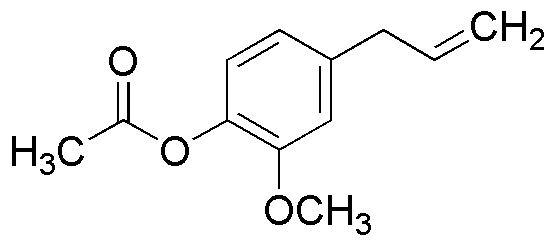Eugenyl acetate is widely utilized in research focused on:
- Fragrance Industry: This compound is a key ingredient in perfumes and scented products, providing a sweet, clove-like aroma that enhances the overall fragrance profile.
- Flavoring Agent: Used in the food industry, it adds a pleasant taste to various food products, particularly in confectionery and baked goods.
- Pharmaceuticals: Eugenyl acetate has applications in the development of certain medications, particularly those targeting inflammation and pain relief, due to its potential therapeutic properties.
- Cosmetics: It is incorporated into skincare and cosmetic products for its aromatic qualities and potential skin benefits, making products more appealing to consumers.
- Natural Insect Repellent: This compound is explored for use in eco-friendly insect repellents, providing a natural alternative to synthetic chemicals, appealing to environmentally conscious consumers.
General Information
Properties
Safety and Regulations
Applications
Eugenyl acetate is widely utilized in research focused on:
- Fragrance Industry: This compound is a key ingredient in perfumes and scented products, providing a sweet, clove-like aroma that enhances the overall fragrance profile.
- Flavoring Agent: Used in the food industry, it adds a pleasant taste to various food products, particularly in confectionery and baked goods.
- Pharmaceuticals: Eugenyl acetate has applications in the development of certain medications, particularly those targeting inflammation and pain relief, due to its potential therapeutic properties.
- Cosmetics: It is incorporated into skincare and cosmetic products for its aromatic qualities and potential skin benefits, making products more appealing to consumers.
- Natural Insect Repellent: This compound is explored for use in eco-friendly insect repellents, providing a natural alternative to synthetic chemicals, appealing to environmentally conscious consumers.
Documents
Safety Data Sheets (SDS)
The SDS provides comprehensive safety information on handling, storage, and disposal of the product.
Product Specification (PS)
The PS provides a comprehensive breakdown of the product’s properties, including chemical composition, physical state, purity, and storage requirements. It also details acceptable quality ranges and the product's intended applications.
Certificates of Analysis (COA)
Search for Certificates of Analysis (COA) by entering the products Lot Number. Lot and Batch Numbers can be found on a product’s label following the words ‘Lot’ or ‘Batch’.
*Catalog Number
*Lot Number
Certificates Of Origin (COO)
This COO confirms the country where the product was manufactured, and also details the materials and components used in it and whether it is derived from natural, synthetic, or other specific sources. This certificate may be required for customs, trade, and regulatory compliance.
*Catalog Number
*Lot Number
Safety Data Sheets (SDS)
The SDS provides comprehensive safety information on handling, storage, and disposal of the product.
DownloadProduct Specification (PS)
The PS provides a comprehensive breakdown of the product’s properties, including chemical composition, physical state, purity, and storage requirements. It also details acceptable quality ranges and the product's intended applications.
DownloadCertificates of Analysis (COA)
Search for Certificates of Analysis (COA) by entering the products Lot Number. Lot and Batch Numbers can be found on a product’s label following the words ‘Lot’ or ‘Batch’.
*Catalog Number
*Lot Number
Certificates Of Origin (COO)
This COO confirms the country where the product was manufactured, and also details the materials and components used in it and whether it is derived from natural, synthetic, or other specific sources. This certificate may be required for customs, trade, and regulatory compliance.

